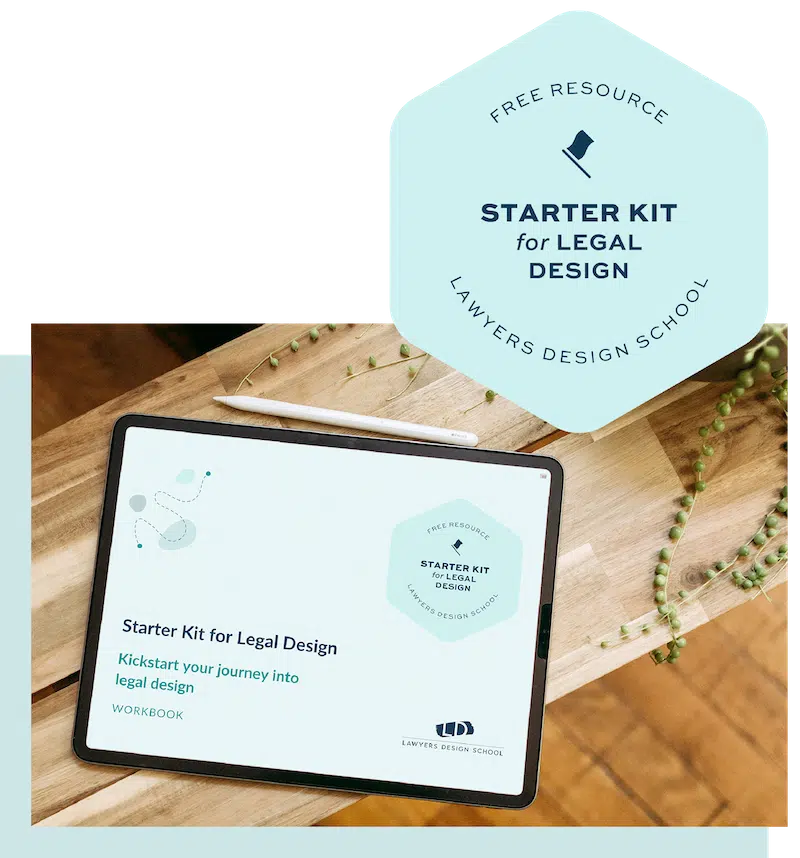Is it legal if I simplify a contract?
Contracts are legal instruments with legal implications and have a long history of interpretation and precedent and this has shaped the way lawyers write and present contracts.
Simplifying contracts challenges tradition but it doesn’t mean it’s not legal. In fact, new laws are requiring contracts to be easier to understand. More on this to come.
If you want to know more about contract design, check out our Contract Design School where you can learn everything you need to know about contract design: simplification, visualization and serve your clients the way you’ve always wanted to.
What is contract simplification?
Simplifying contracts means taking a traditional “serious-looking” legal contract with
- Small font, non-existing spacing, and no white space
- Loads of legalese and long words
- Paragraph-long sentences that are impossible to read
- The most important information is buried somewhere in the detail
And then you make it more simple, using
- A clear and user-friendly structure
- Plain language
- Visual aids to help the user.
What are the benefits of contract simplification?
When contracts are easy to understand it means they’re easy to follow and comply with. Simplification increases transparency and transparency increases trust. Trust in you, your customer and everyone else involved in the deal.
This is great for you, your customer and their customers or partners – and the regulators.

STARTER KIT FOR LEGAL DESIGN
Free resource
Get this free resource to kickstart your journey into legal design.
Add empathy, simplicity, and creativity to your legal work and elevate customer experience.
Regulators want simplified contracts
Traditionally contracts are written by lawyers, for lawyers with the goal of preventing disputes.
And this technical legal drafting affects the parties entering the contracts because they’re often unable to understand them.
Regulators are paying attention to the dilemma of complexity because it hinders people and businesses from exercising their rights.
Back in 2007, the European Union issued the Markets in Financial Instruments Directive which was the first in a wave of new laws to change the regulation of the financial services industry. This change continues today.
At the time, I was in-house counsel in a bank and I was charged with simplifying and re-designing our contracts to comply with the directive. I had to re-write pages and pages of documents so everyday investors could understand the contracts they were entering into (without omitting any information they needed to know). It wasn’t easy and I wish I had access to the contract simplification tools I have available today.
In 2018 the General Data Protection Regulation (GDPR) required companies to present their privacy information in a way that made it possible for the user to understand how their information was being collected and processed.
This regulation has helped companies jump-start their contract design journeys by using their privacy information as a starting point.
Regulators can see that traditional legal drafting is not useful to anyone but lawyers.
Why lawyers are concerned about changing contracts
The law requires particular words
Certain situations require particular information or specific legal language to ensure a contract is valid and that’s fine.
Contracts of employment are often regulated and codified meaning they need particular information and legal terms to comply with the regulations. Your expertise as a lawyer is to know these requirements and make sure the contracts include them.
But even in these situations, I urge you to revisit the regulations and see what they really do require. Do they require you to use expressions like “shall” or “notwithstanding the foregoing”? I doubt they do.
Lawyers often overestimate the impact of legal regulations on contract language and underestimate the room for simplification.
“More often tradition and habit tell us what “should” be in a contract, rather than the actual regulation or case law.”
So be mindful of the difference between what is required and what is just copied for the sake of tradition.
Contract simplification increases risk
Lawyers don’t like risk and I get that. We want to cover every single scenario in our clauses.
But this approach is lawyer-centric and our customers lose out because they don’t understand what they’re signing.
I get it. The complex language is the language lawyers can speak. And it’s easy to keep speaking in that language, especially when change means re-evaluating the risks involved with the simplified language.
Don’t be afraid of the re-evaluation – talk about it
It’s a perfect opportunity for a team meeting and an open discussion.
Talk about
- The level of uncertainty you and your business or team are willing to accept
- When you write, how much “grey” is your lawyer mind willing to tolerate – do you need to cover every imaginable (yet unlikely) scenario?
- Can you find different ways to say something and still cover the most important points and risks?
- Would you be helping your customer more with simple language, even if it didn’t cover each and every scenario you can think of?
Simplifying contracts is not about dumbing down or opening the doors for uncontrollable risks. Simplification invites you to learn a new language so that you can serve your customers better.
After all, the contracts are not about or for you.
But visuals can’t replace words
Valid contracts can include images, illustrations and visual elements.
It’s impossible to give any exhaustive example that would cover every jurisdiction to support this, but the High Court in the United Kingdom held that illustrations and worked examples are an integral part of a commercial contract.
In this case Altera v Premier Oil (Altera) the High Court recommended the use of illustrations to explain complex content. And at the same time, Altera is a good reminder that the same rules and recommendations that govern contract text apply to illustrations as well.
Ultimately the use of visuals in contracts is not a black and white question. The idea is not to replace the text with visuals, not even in comic contracts.
“Simplification means that you can use illustrations and visual aids to support the reading and understanding.”
You can add a diagram to explain a process or timeline and still have the clause written next to the diagram. You can use both.
This will help all users, not just those who have challenges with reading.
When you think about your contracts, can you think of a clause or content that could use some visual aids to help the customer to understand the meaning?
Layering and simplifying contracts
One practical way to approach the whole dilemma of simplifying contracts and ensuring their validity is a tool called layering.
I learned about this from Rob Waller at Simplification Center. I’ve talked about layering more in detail in episode 15.
The idea behind layering is simply this:
You don’t have to change the original contract at all. You can simply create different layers of the contract for different users.
Since there are many users for the same contract, you can serve each of them with their own layer. And these layers can live in the same contract document.
You can think about the original contract language as the source code and the other layers are user interfaces to that code. Just like an app on your phone – every app has the source code the developer references and then there’s the interface we access and know how to use intuitively.
This same logic applies to contracts.
Layering and contract validity are things we focus on in our contract design workshops.
Curious?
If you’re interested in contract design I have a great free resource for you: A Starter Kit for Contract Design that helps you hone in on the ways you can get creative and simplify your contracts.
Legal design thinking: IRL. Episode 25
You’ve just read a summary of my LinkedIn Live. I’m Hannele, the founder and CEO of Lawyers Design School and I’m on a mission to transform legal space with human-centered design (better known as legal design). I teach you how to add a creative and human touch to your everyday work as a lawyer so that you can be the lawyer your clients and the world need you to be.
If you’ve read something that interests you please join me next week.
You can catch a replay of episode 25 here Legal Design Thinking: IRL or join me live and ask questions.
Ask a question
Feel free to DM any questions or join me on LinkedIn every Wednesday at 8 am ET where you can ask me about legal design and growing your law firm.
Follow me at @lawyersdesignschool for more tips and tools.
Prefer email? Drop me an email at [email protected]. And while you’re here, take a peek at the Lawyers Design School and the contract and legal design courses we offer to help you thrive in your legal career.
Watch all the Legal Design IRL episodes.

STARTER KIT FOR LEGAL DESIGN
Free resource
Get this free resource to kickstart your journey into legal design.
Add empathy, simplicity, and creativity to your legal work and elevate customer experience.

